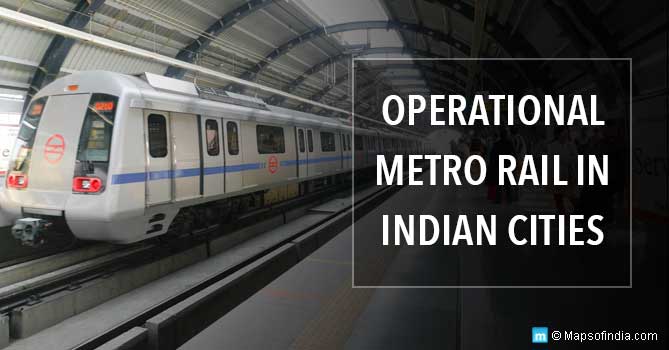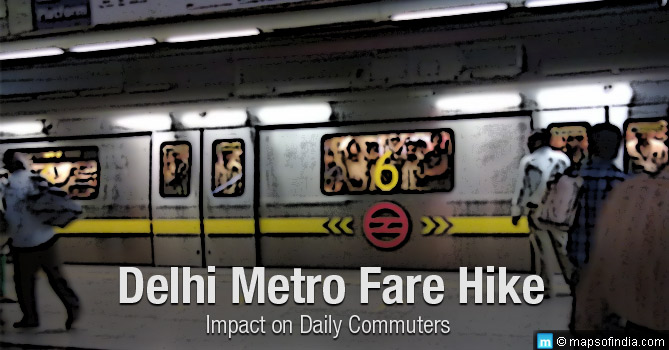An increase in population has lead to the growth of traffic in India. To ease the traffic situation in the country and make travel convenient for the people, the government has introduced the metro rail in many cities.
India has introduced Mass Rapid Transit System (MRTS), which is currently operating successfully in 10 cities in India. Construction is going on in 5 cities namely Nagpur, Noida, Navi-Mumbai, Pune and Metro link express for Ahmedabad and Gandhinagar, which would be operational soon. Mass Rapid Transit System in India is commonly known as “Metro”. It is a cheap mode of travel, which helps in reducing the energy consumption, is eco-friendly, and is the reason behind the prevention of accidents. The modern design of metro coaches, the stylish appearance of metro stations, and superior comfort facilities are some of the reasons why metro is becoming popular in India. The journey appears to be more fruitful due to the services like ATMs, food outlets, cafés and convenience stores at the metro stations.
Let us look at the metro rail network in operation across the country:
Kolkata Metro is the oldest operated Metro in India. It is the only metro which functions directly under the Indian Railways. Kolkata Metro’s foundation was laid in the year 1972 and it was first opened for commercial services in 1984. There are 24 stations and it is operational for 27.22 kilometres. Large-scale expansion is going to take place in the project of Kolkata Metro as nearly 113 kilometres area is under construction. The metro service is quite popular among the residents of Kolkata.
Delhi Metro is the second oldest metro after Kolkata Metro. It was completed in the year 2002 and is spread over 231 kilometres. It is the largest operational metro in India and has 173 stations. The Delhi Metro Rail Corporation (DMRC) has an airport express line and seven other metro lines. It is the only metro line in India which was certified as the first metro rail and rail-based system in the world to get “carbon credits for reducing greenhouse gas emissions” by the United Nations. It has helped in reduction of pollution levels in the city by 630,000 tonnes every year. There are roof top solar power plants at many stations of Delhi Metro. DMRC has partnered with Google India, which provides train schedules and route information to mobile devices with Google Maps. Delhi Metro is still spreading, around 140 kilometres area in Delhi is under construction and the construction is expected to get completed in 2018.
Namma Metro (Bengaluru Metro) is the second largest operational metro in India after the Delhi Metro. It also has an underground metro line which is the first underground metro line of South India. Bangalore metro has 2 lines- Purple and green – and 41 stations. It was opened in the year 2011. It is operational along a route of 42.3 kilometres in Bangalore and approximately 34.37 kilometres is still under construction. The detailed project of Bangalore Metro Rail Corporation (BMRC) was prepared and submitted by Delhi Metro Rail Corporation to BMRCL.
Rapid Metro Gurgaon is the world’s first fully privately financed metro system built in India. It is operated by the Rapid Metro Rail Gurgaon Limited (RMGL). One can access Rapid Metro from Sikandarpur Metro station, which is within the Delhi Metro. Rapid Metro was opened in the year 2003 and covers 11.7 kilometres. It is serving 11 stations. Rapid Metro is also the first metro system in India which had an auction for naming rights of stations. The Rapid Metro Gurugram provides transport around Cyber City, DLF Phase 2, DLF Phase 3, NH-8 & Golf Course Road up to Sector 55-56 of Gurugram.
Mumbai Metro was built in three phases over a period of 15 years. Currently, only 1 line is operational over a stretch of 12 kilometres while 69-kilometre area is under construction. The metro was opened for public in the year 2014 and is serving the financial capital of the country.
Jaipur Metro Rail System is the sixth metro rail system in India after Kolkata, Delhi, Bangalore, Gurgaon, and Mumbai. Jaipur Metro Rail Corporation (JMRC) is a state-owned company. There is one operational line and another is planned under Jaipur Metro. Currently, there are 9 operational stations while 22 stations are planned. Jaipur Metro was started for Rapid Transit System in the city. It is the first time in the history of India that most of the route of Jaipur Metro is elevated with a double storey. The metro is completely safe despite being elevated double storey as it has received safety clearance from Commissioner of Metro Rail Safety (CMRS).
Chennai Metro is a convenient, modern and economical mode of public transport in Chennai. It is properly coordinated with other forms of public and private transport, which include buses, suburban trains, and MRTS. Chennai Metro has two color-coded lines – Green and Blue. It came in operation on 29 June 2015. The total operational network of Chennai Metro is spread to 28 kilometres and there are currently 20 stations. Nearly 20 kilometres more area is still under construction. The Chennai Metro Rail Corporation is a joint venture of the Government of India and the Government of Tamil Nadu.
Kochi Metro is the first metro rail project in India which connects rail, road and water transport. Every metro station in Kochi is designed keeping in mind a specific theme around culture and geography of Kerala. Kochi Metro is operational within 19 kilometres and has 16 stations. Nearly 26 kilometres area of Kochi Metro is under construction.
Lucknow Metro is the fastest built metro in the country. The Lucknow Metro Rail Corporation is a joint venture of Government of India and Government of Uttar Pradesh. Only one line is operational in Lucknow Metro, while the other is under construction. There are 11 planned stations and 8 operational metro stations. Around 33-kilometre area is under construction for expanding Lucknow Metro.
Hyderabad Metro rail system is the largest elevated Metro rail Private Public Partnership (PPP) in the world. It covers a stretch of 30 kilometres. The Hyderabad Metro is based on DBFOT basis (Design, Built, Finance, Operate and Transfer). There are 24 operational stations and 2 operational lines. Around 42 kilometres area is under construction, which is expected to be completed by the end of 2018.
The Indian economy is growing at a rapid pace and the lifestyle of the people is also undergoing a change. In the years to come, more cities will likely get their metro rail. This would definitely ease traffic and make traveling more convenient.
Ahmedabad Metro
Ahmedabad Metro is a rapid transit system. The metro project in Ahmedabad, Gandhinagar is being constructed by Gujarat Metro Rail Corporation (GMRC) to execute all metro projects in Gujarat. As far as the length of the Ahmedabad Metro Rail Project Phase-I is concerned, it is approximately 40.03 km out of which 6.5 km is underground while the rest of the stretch is elevated. It has been connecting four corners of the Ahmedabad city with two corridors and 32 stations. Construction of phase II of the Metro rail project is underway to connect the twin cities of Ahmedabad and Gandhinagar. This project will cover a distance of 28.2 km.
Noida Metro
The Noida Metro is a rapid transit system, which is connecting two cities Noida and Greater Noida. Phase-1 of the project has been completed. It has 21 stations, and it costs Rs 5,503 crore. Its total length is 29.7 km(18.5 miles ). This line is known as the Aqua line, while all the stations are elevated.
Meanwhile, the phase-2 project is under pipeline, which would have nine stations. The construction of Noida Metro is being done by Noida Metro Rail Corporation (NMRC).
Nagpur Metro
Nagpur Metro is a rapid transit system; this metro project got Union government approval on 20 August 2014. Construction on the project kicked off in June 2015. It consists of two corridors with a total length of 38 kilometres, will have 38 stations like Delhi metro there is an exceptional coach for women “Nari shakti” in each metro train. The first phase of the Nagpur Metro was flagged off on 8 March 2019 by prime minister Narendra Modi via video link. The inaugural phase is of 13.5 km from Khapri to Sitabuldi. Nagpur Metro is the 13th metro operational in the country and is considered as the greenest metro rail in the country. At least 65 per cent of its electricity is generated from the solar metro, total expenditure on this project is expected to exceed Rs 8680 Cr.
Read More…





